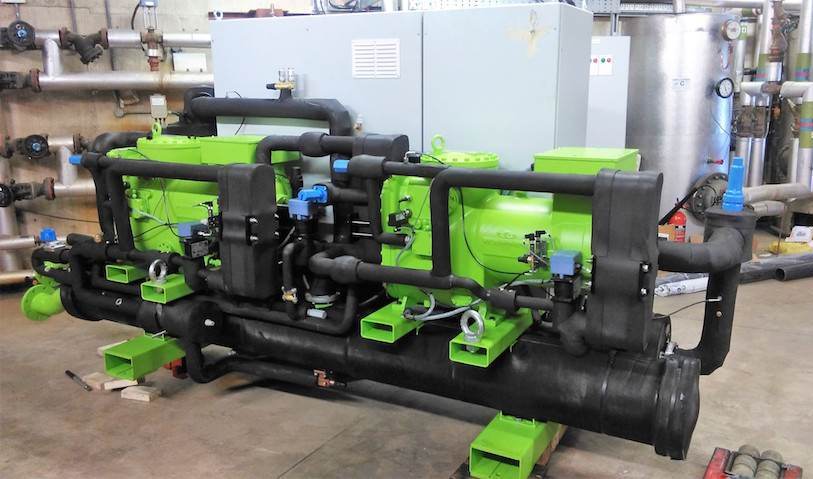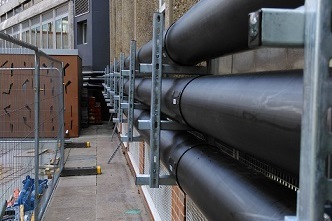Groundwater Heat Pumps
Groundwater heat pumps are an under-used technology in the UK. Harnessing renewable energy from aquifers represents a huge opportunity to provide low carbon heating and cooling to buildings.
A groundwater source heat pumps Code of Practice has been produced CIBSE and the GSHPA with the backing of the HPA and is available at CIBSE CP3. The Code of Practice warns that there may be risks of fragmentation and lack of responsibility if different parties are employed on feasibility, detailed design, construction and maintenance.
CP3 Open-Loop Groundwater Source Heat Pumps: Code of Practice
As well as providing an comprehensive description and checklist of the various elements of an installation – from feasibility, through design, construction, commissioning and operations – the Code includes a number of useful case studies of installations of groundwater source heat pumps in the UK.
The Code of Practice examines the options for extracting heat from groundwater to provide heating and rejecting heat to groundwater to provide cooling. The aim is to provide developers with guidance on where Groundwater Heat Pumps can be used to provide large scale heat transfer in densely populated urban areas and raise the standards of design and implementation of groundwater heat pumps in district heating systems.
Groundwater heat pumps benefit from the thermal inertia of groundwater
A heat pump can concentrate heat by compressing refrigerant gases into a small volume and then transferring the heat into buildings to provide warmth via heat exchangers. The refrigerant gas becomes cold when the pressure is released and this coldness can be exchanged with warmer water from the ground – and the cycle can be repeated continuously. The effect is to transfer heat from groundwater into buildings to heat them and provide domestic hot water.
Some interesting points to note:
- heat pumps will become more common as the UK decarbonises its heating systems
- the use of heat pumps is growing as the government subsidises low-carbon heat sources with the Renewable Heat Incentive
- air source heat pumps, which heat exchange with ambient air, are cheaper to install than ground source heat pumps, but they are at their least efficient on the coldest days when heat is most needed.
- groundwater is warmer than the air in winter, so a groundwater heat pump is more efficient than an air source heat pump – because of the thermal inertia of the water in the ground.
- groundwater is colder than the air in summer, so a groundwater heat pump is more efficient at releasing heat from a building than an air source heat pump – because of the thermal inertia of the water in the ground.

Advantages of Groundwater Heat Pumps
Water has a high capacity to hold heat in relation to its volume; it readily absorbs heat and readily delivers it: it enjoys a high transfer rate.
It is more efficient for a heat pump to exchange heat with water than air – which enables a water source heat pump to outperform and air source heat pump. A ground source heat pump also uses water to transfer heat from the ground to its heat pump.
The thermal capacity and thermal inertia of water enables it to retain some of the solar heat gained in the summer through to the winter. Groundwater in aquifers, will be warmer than the air temperatures on cold winter days and thus provide a more attractive input temperature to a heat pump.
A well engineered groundwater heat pump system has access to a large volume of water: this enables it to extract heat from a large heat source whose temperature will not change significantly as relatively small amounts of heat are extracted from it.
The London aquifer holds a very large source of water at constant temperature throughout the year. This can act as a valuable source of heat for groundwater heat pump systems, such as the Balanced Energy Network at London South Bank University.
Disadvantages of Groundwater Heat Pumps
The disadvantages of an open loop groundwater source heat pump system include the need to meet the additional engineering challenges of dealing with water which may contain debris, unstable pH values or biological growth and may call for additional pumping loads. It will also be necessary to meet the abstraction requirements of the Environmental Agency on all but the smallest of schemes. Most of these problems can be sidestepped by employing a closed loop system with heat exchangers immersed in the groundwater.
The key disadvantage of using a very large body of water to achieve heat exchange with a relatively constant temperature is that you are not able to store summer heat in that body of water – to have the benefit of retrieving those higher temperatures in winter.

Heat pumps can play an important role in balancing supply and demand
It has been said that: "Heat pumps could also play an important role in balancing supply and demand in future energy systems. Electricity is difficult to store, but heat can be stored easily in the form of hot water."
In fact, heat pumps will be able to play a far more significant part when it is understood that heat pumps can do much more than store a small amount of heat overnight in small hot water tanks: heat pumps can play a significant part in interseasonal heat transfer systems when the ground itself can be used as a very large store of solar heat energy from summer to winter.
Electrification of Heat
There are now new ways of organising information and temperature to provide renewable heating and renewable cooling by recycling heat in district circuits.
The search for new techniques to control carbon emissions is advancing. There are alternatives to burning fossil fuels to keep us warm in winter – and cool in summer. The answer is to recycle heat between seasons and within districts – and by recycling heat it is also possible to provide heating without contributing to urban air pollution.
Demand Response and Distributed Heat Storage
The demand for electricity fluctuates during each 24 hour day. The supply of electricity also fluctuates, with photovoltaic cells generating electricity on clear days and wind turbines when the wind is blowing.
The National Grid must be able to guarantee power at times of peak demand.
"Demand Response" can be used to stimulate use of electricity at off-peak times (by lowering prices) and to discourage use of electricity at peak times (by increasing prices). Demand response goes hand-in-hand with temporary heat storage in insulated hot water cylinders: a low price signal can be used to trigger heat pumps to increase the temperature of DHW storage.
Balanced Energy Networks
An Innovate UK funded demonstration is pioneering the electrification of heat in the Balanced Energy Networks project in central London.
Shoreham Harbour Heat Network
ICAX is a partner in the £31m SmartHubs project which is building a district heat network in Shoreham Harbour based on marine source heat pumps provided by ICAX. The SmartHubs project is also establishing a Virtual Power Plant in West Sussex to help balance supply and demand for electricity in the local smart grid.
See Low Carbon Heating See Low Carbon Cooling See Ground Source Energy See Smart Grids



